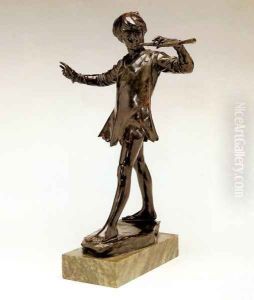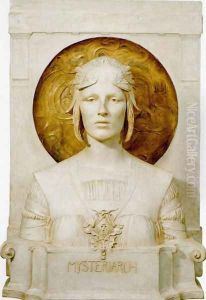Sir George Frampton Paintings
Sir George Frampton was an influential British sculptor and a leading member of the New Sculpture movement, which sought to break away from the traditional approaches to sculpture in the late 19th and early 20th centuries. Born on June 18, 1860, in London, England, Frampton was the son of a stonemason, which exposed him to the craft from an early age. He initially trained at the Lambeth School of Art and later attended the Royal Academy Schools, where he honed his skills and developed his distinctive style. Frampton's work was characterized by its intricate detail, allegorical themes, and innovative use of materials, including bronze, marble, and colored stones.
Frampton achieved widespread recognition and acclaim for his public monuments and memorials, as well as his smaller, more intimate portrait busts and reliefs. One of his most famous works is the Peter Pan statue in Kensington Gardens, London, unveiled in 1912. This enchanting sculpture, commissioned by author J.M. Barrie, perfectly captures the whimsy and magic of the Peter Pan story and remains a beloved landmark. Frampton's ability to convey emotion and narrative in his sculptures made him a favorite among the intellectual and artistic elite of his time.
Throughout his career, Frampton was honored with numerous awards and distinctions. He was elected to the Royal Academy in 1902 and knighted in 1908 for his contributions to British art and sculpture. Despite his success, he was known to be a modest man who focused deeply on his craft, often exploring themes of nature, mythology, and the human spirit. Sir George Frampton's legacy is marked by his significant influence on the development of sculpture in the modern era. He passed away on May 21, 1928, leaving behind a body of work that continues to be celebrated for its creativity, craftsmanship, and beauty.

